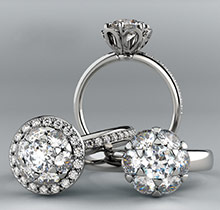While diamonds may be a girl’s best friend, they aren’t your wallet’s best friend. Natural diamonds are expensive, especially for larger stones, higher quality, and higher quantities. If you want the bling of diamonds without the price tag, you have two options: synthetic diamonds or diamond simulants.
Synthetic diamonds are laboratory-grown crystals, produced in an artificial process, that have the same chemical composition, molecular structure, and optical characteristics as natural, mined diamonds. Most jewelers prefer to call these diamonds lab-grown diamonds, lab-created diamonds, or cultured diamonds rather than synthetic diamonds because this term has confused many consumers, leading them to believe these diamonds are fake or imitations. Lab-grown diamonds look identical to and are chemical identical to mined diamonds. Like mined diamonds, lab-grown diamonds are also available in colors. While lab-grown diamonds will still cost significantly more than most diamond simulants, they will cost about 20 to 30 percent less than mined diamonds.
Diamond simulants are any material, natural or man-made, that are used to substitute for diamonds. These stones have similar gemological characteristics to diamonds but are not true carbon crystals. They do not have the same chemical and physical properties as diamonds. Diamond simulants sell at lower prices than mined, or even lab-created, diamonds. Common diamond simulants include:
- Cubic zirconia
- Moissanite
- White sapphire
- Rhinestone
- Quartz
- Topaz
High quality simulants used in the right way can create a beautiful piece of jewelry that has the appearance of diamonds without the hefty price tag. As an added benefit, using a diamond simulant or a synthetic diamond gives you the reassurance that your stones are conflict-free, a concern for many people when buying diamonds.


